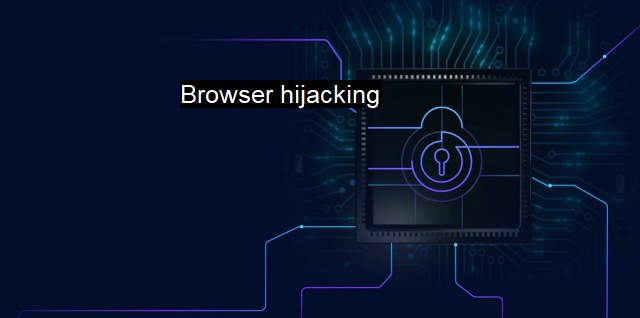What is Browser hijacking?
Understanding and Preventing Browser Hijacking: A Dangerous Cyber Attack Targeting Popular Browsers for Malware Distribution and Information Theft
Browser hijacking refers to interfacing with a web browser's controls, settings, or functions without user consent. Often facilitated by malicious software or potentially unwanted programs (PUPs), browser hijacking is a common threat in the sphere of cybersecurity. This delivers antisocial hackers with a robust benefit in infringing computing and networks. When successfully launched, browser hijacking can endanger users' privacy, render browsers unusable, or drive fraudulent activity.In most incidents, the hijacking manifests through an altered homepage, rerouting of web searches to unfamiliar pages, supplementary toolbars on the browser, or a flood of unsolicited popup ads. While these symptoms might seem benign nuisance, they sometimes have a disastrous impact.
The activities performed by web browser hijackers bridge more than just plain inconveniences. User information confidentiality is at peril as the hijacking element might gain access to sensitive data inputted on the browser. These involve login credentials of banks, credit card numbers, contact addresses, etc. Some hijackers surreptitiously download more Malevolent software that could steal private data or carry out DDoS attacks on other networks. The ultimate malicious goal primarily includes generating ad profits, initializing click fraud, or distributing malware.
The methods and means by which browser hijacking make an entry into a system are complex and shifting. Typically, unrequired browser extensions, software bundles, and email attachments have been attributed to being the culprits. Also, free downloadable software or applications offered at underregulated websites constitute viable carriers, veiling the hijackers under the freeware cloak.
Organizing adequate preventive measures constitutes a critical linchpin to tackling browser hijacking. Wielding powerful antivirus software represents an influential counteraction means. It delivers robust defense through real-time scanning for threats, executing virus removal protocols, and scheduling regular system scans. Even updating installed applications, software, and the operating system is crucial. These updates typically adjoin patches that repair vulnerabilities targeted by hijackers, infusing additional strength levels to system security and often overlooked by general users.
Promoting safe browsing habits underscores yet another paramount dimension in circumventing browser hijacking. This encompasses avert engagement with suspicious emails, avoiding clickbait, cautiously observing site certificates before sharing sensitive information, and abstaining from flippantly granting software install permissions.
When dealing with an already hijacked browser, antivirus software can help, as many modern suites offer capabilities to handle, detect and eliminate browser hijackers. Specialized software tools called anti-malware software have increased efficiency in detecting and removing such malicious software, while also preventing future intrusions. Timely technical support should be engaged for efficiently removing the hijacking elements if the situation goes beyond individual handling.
To recap, browser hijacking refers to the unauthorized interference of browser functions by malicious agents, synonymous with significant threats to user privacy, security, and overall digital wellness. 'Internet hygiene', referring to maintaining regular updates and safe browsing habits, reinforced by formidable antivirus and anti-malware software deployment makes a solid defense strategy against browser hijacking threats. In a world of increasing cyber-attacks, it becomes imperative to remain alert, informed, and prepared for these intrusive attacks.

Browser hijacking FAQs
What is browser hijacking?
Browser hijacking is a type of cyber attack where a malicious program takes over your web browser without your knowledge or consent. The attackers can manipulate your browser settings, modify your homepage, redirect your search queries, and inject unwanted ads.What are the signs of a browser hijacking attack?
Some common signs of browser hijacking include sudden changes in your browser settings, unfamiliar toolbars or extensions, frequent pop-up ads, inability to access certain websites, and sluggish browser performance.How can I prevent browser hijacking?
You can prevent browser hijacking by installing and regularly updating a reputable antivirus program, using a firewall, avoiding suspicious websites, not clicking on unknown links, and being cautious when downloading and installing free software.What should I do if my browser is hijacked?
If your browser is hijacked, you should immediately disconnect your computer from the internet, run a thorough scan with your antivirus software, reset your browser settings to default, and change your passwords. If the problem persists, seek the help of a cybersecurity professional.| | A | | | B | | | C | | | D | | | E | | | F | | | G | | | H | | | I | | | J | | | K | | | L | | | M | |
| | N | | | O | | | P | | | Q | | | R | | | S | | | T | | | U | | | V | | | W | | | X | | | Y | | | Z | |
| | 1 | | | 2 | | | 3 | | | 4 | | | 7 | | | 8 | | |||||||